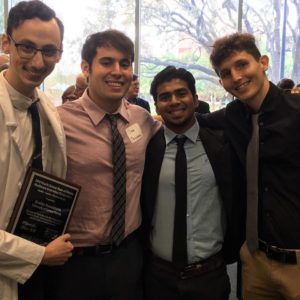IROH
In late 2015 an undergraduate engineer named Sam Drucker was hard at work with Limbitless, a non-profit organization that had recently exploded into the spotlight. Limbitless gained popularity by designing and engineering 3D printed myoelectric prosthetics and had just finished showcasing an Iron Man arm with the assistance of Tony Stark himself, Robert Downey Jr. After an intense amount of press coverage, Limbitless’ waitlist grew by the hundreds. This provided Sam with a realization, the biggest barrier to getting more people 3D printed prosthetics was the fact that the process was not automated. There was no way to simply scan a residual limb to take the necessary measurements and employ a program which would automatically design and size a customizable 3D printed prosthetic. It was from this idea that the concept of IROH (Integrated Robust Orthotics and Prosthetics Hyper-Customization) was born.
Fortunately for Sam (who had just accepted a position interning at SpaceX), he did not have to bring the idea to a fully-fledged business model and minimum viable product alone. He sought out the help of some of his best friends and formed what would become Team IROH, an interdisciplinary group of students focusing on both medicine and engineering. Team IROH grew to include Brad Rosenkrantz, a second year medical student who already had years of experience developing Point-of-Care diagnostics for Tuberculosis; Sheikh Salauddin, a mechanical engineering student who is currently the senior intern at Earthrise Space Foundation, a company which is participating in the Google Lunar XPRIZE competition; and Brandon Lowe, a mechanical engineering student who is working under Dr. Robert Steward in investigating the response of endothelial cells to mechanical forces.
After meeting with patients, prosthetists, researchers, designers and international outreach organizers during our time participating in I-Corps, IROH evolved. It became obvious that in order to address the value of the clinician-patient interaction, a user friendly interface was necessary. This would allow the wants and needs of the patient to be expressed such as functionality while the clinician can input anatomical constraints such as residual fingers or bony prominences. Additionally, a fully accessible database of previously designed open-source 3D printed prosthetics would allow different options for both the clinician and the patient.
Team IROH additionally identified the market potential of their technology. By speaking to prosthetists, the team realized that they had created a device that the clinician can utilize to enhance their ability to treat patients. They also identified the potential to expand into a double -sided market. A humanitarian aspect of the project had always been apparent, however after speaking to experts involved in developing medical devices and prosthetics in 3rd world countries, another major pivot occurred. A truncated program could be created so that the patient themselves could input information in and replace the clinician, allowing an increased access and the ability to impact more people across a global scale.
The team is excited to watch their business develop and extremely grateful for everything they learned through the I-Corps Program.



